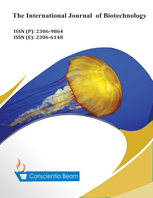Antioxidant and Antimicrobial Efficacies of Withania Coagulans Seed Extract against Pathogenic Bacteria and Fungi
DOI:
https://doi.org/10.18488/journal.57/2016.5.3/57.3.45.51Abstract
The present study was conducted to evaluate the nutritional profile, phytochemical screening, antimicrobial and antioxidant activities of aqueous and acetonic extract of Withania coagulans by standard chemical analysis methods. Proximate analysis revealed that aqueous extract of W. coagulans is a rich source of soluble solids (16.1 ± 1.5 %), fiber (15.5 ± 0.1 %), pH (11.5 ± 0.19 %), ash (11.2 ± 0.2 %), sugar (9.7 ± 0.1 %) and ascorbic acid (9.7 ± 0.1 mg/100ml). Phytochemicals detected were flavonoids, glycosides, carbohydrate & sugar, phenolic compounds, proteins & amino acids, tannins, gum and mucilage while phytosterols were absent. The antifungal and antibacterial activities of plant extract was determined against ten pathogenic bacterial strains (Escherichia coli,Bacilluscereus, Staphylococcus aureus,Clostridium, Escherichia coli (Human), Bacillus subtilius, Xanthomonas, Salmonella typhi,Salmonella heidelberg and Klebsiella pneumonia) and five fungal strains (Penicillium, Aspergillus niger, Alternaria alternata, Entomola and Aspergillus flavus) using the agar well diffusion method. The acetonic extract of W. coagulans indicated highest antibacterial activity (12 mm) against Clostridium and Salmonella heidelberg and lowest action (5 mm) against E. coli (Human.). Highest antifungal activity (10 mm) was recorded against Alternaria alternata and Penicillium while Aspergillus niger showed lowest zone of inhibition (6 mm). Streptomycin was used as a control. The acetonic extract of W. coagulans exhibited highest free radical [(1, 1-diphenyl-2-picryl hydrazyl (DPPH)]) scavenging activity (72 %) at concentration of 30 mg/ml, with an IC50 value (18µg/ml) as compared to control (4µg/ml). The presence of bioactive compounds, nutrients and biochemical screening indicated that the seeds of W. coagulans can serve as a potential source of useful drugs for the treatment of various pathologies.

